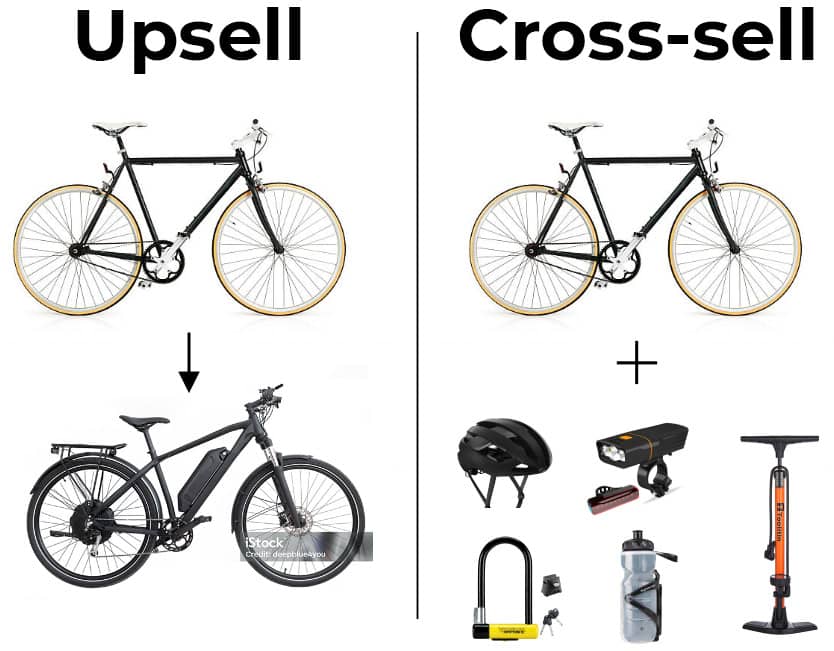Upsell
Is offering a pricier version of the same product or service. For example, upgrading from an 8-megapixel camera to a 12-megapixel one or switching to a higher-tier subscription plan to access additional features or process a larger volume of transactions.
Upselling shouldn’t be unethical or manipulative. It’s crucial not to upsell something that your prospect doesn’t require or can’t afford. Instead, consider the upsell as a way to provide them with an improved experience or greater value. Perhaps your prospect hasn’t yet considered the benefits of a waterproof phone, but you’ve recognized that it aligns with their lifestyle and hobbies. Or your prospect may be interested in your standard SEO package but hasn’t fully grasped the added value and impact of ongoing content creation, which is a key feature of your comprehensive SEO package offered at a slightly higher price.
Using Mailchimp again as an example, they offer a pay-as-you-go credit “plan” (e.g. 1 credit per email sent) and various credit top-up options ($100 for 100 credits, $200 for 220 credits, and so on). They also provide tiered options permitting unlimited sends based on the number of recipients.
A prospect might initially opt for the credit option, believing they send a low volume of emails, despite the occasional mass email campaigns. In this scenario, upselling them into a tiered plan would not be unethical; in fact, it would benefit them more. Although the tiered plan may have a higher monthly cost, the savings from sending those occasional mass emails are substantial when considered over a year.
An ethical approach to upselling is about providing prospects with the freedom to choose based on their needs and preferences. Focus on building trust and being transparent. It’s never wrong to present better options for your prospect, as they may not have considered it or know as much as you do about your market.
Cross-sell
A cross-sell is when you offer a complementary product or service that is different from your primary offering. It’s often designed to enhance or complete the prospect’s experience or provide additional value. Unlike an upsell, which encourages the prospect to buy a more expensive or upgraded version of the same product or service, a cross-sell introduces something new to the prospect.
Here’s an example:
- Upsell: When you’re buying a smartphone, the salesperson encourages you to choose the higher storage capacity model of the same phone you intended to buy.
- Cross-sell: While you’re buying a smartphone, the salesperson suggests purchasing a high-quality phone case or screen protector to protect your new device. The case and screen protector are different products that complement the smartphone purchase.

Bundling
Grouping items as a package is another way to cross-sell. Like all techniques, it’s not inherently unethical and depends on how you use it. Fast-food meal combos (including a drink and fries) are one example of bundling. Another example would be if you bought a bicycle, and the SDR offered you a starter package that includes a helmet ($30), a water bottle ($10), and a bicycle lock ($70) together for $90 (saving you $20).
Amazon is arguably not the best ethical example. However, you can learn from what works because you’ll probably most readily recognize this. Their digital “items often purchased together” and “similar products” sections, which appear on every product page, expose users to other complementary products they may not have considered. This contributes to increased cross-sales.



When it comes to cross-selling, the most common objection from SDRs is that they feel uncomfortable pushing more offerings right after closing a sale. This discomfort stems from approaching cross-selling with the wrong mindset. Cross-selling, like upselling, should not be seen as unethical or manipulative. It involves presenting related offerings that enhance the prospect’s overall experience, meet their needs, or fulfill additional requirements. If you properly ASSESS your prospect’s needs, you shouldn’t find yourself pushing additional offerings that your prospects don’t require. Your complimentary offerings should add value and support your primary offering. For example:
“Would you like to add breakfast for 2, normally $49, to your room for just $29?”
Is more affordable, convenient, better value, and enhances their experience. Profit should never be your objective. Aim to help your customers succeed. By focusing on providing convenience and helping them save more money, you will naturally maximize the transaction’s value. Profit is the result that follows.
Timing is crucial when attempting to cross-sell
If you do it too early or too late in the interaction, your prospect might misunderstand and perceive it as a desperate attempt to earn more commission. Like when asking for a review or testimonial, the best time to position a cross-sell is after reaching a positive milestone in your customer’s journey. Common positive milestones include:
- Right after they’ve agreed to buy your main offering: They see clear value and are ready and excited to move to the next step.
- After they’ve begun using your solution and see its value (set up automatically triggered email campaigns).
- If a customer has left a positive review or made a referral: You might want to follow up right after to reward their compliment by offering them something that complements their original purchase or fits well with how they use your solution.
By choosing the right timing, you’re more likely to engage your customers in a way that feels helpful and valuable, rather than pushy.
Here are some different ways to frame the upsell or cross-sell:
| Offline (In-person) | Online |
|---|---|
| “You may also like…” “This is a more fully featured item than the one you’re looking at” “I think this would be a better fit for you because…” | Explaining your different offerings, what they’re suitable for, or showcasing other products that complement and augment the main offering. Done via: Newsletters, Tutorials, Blog posts Recommendations on your product page: Customers also liked/Similar items/Often purchased together |
